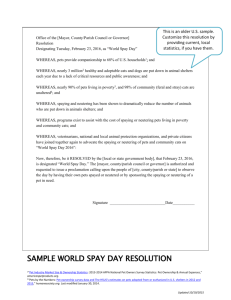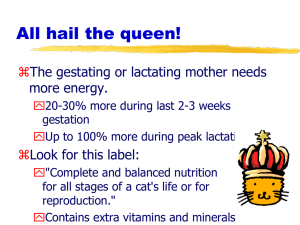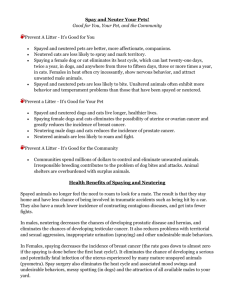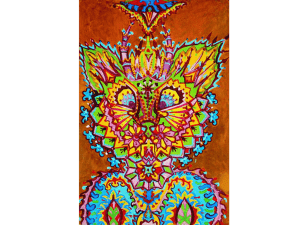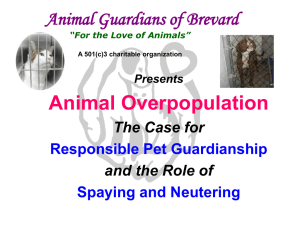Spaying & Neutering - PEER
advertisement
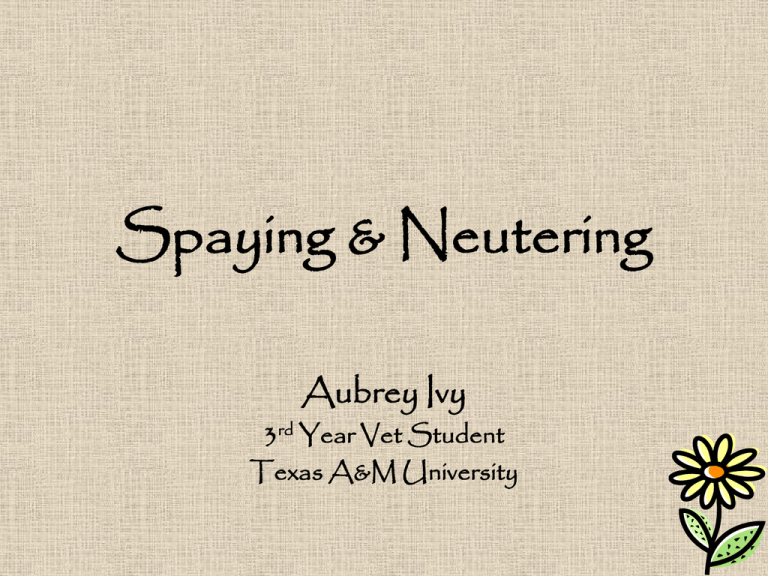
Spaying & Neutering Aubrey Ivy 3rd Year Vet Student Texas A&M University Introduction • Class of 2009 veterinary student • How I got here: – High School Diploma – Bachelors Degree in Biomedical Science (4 years) – Veterinary School (4 years), 1 ½ to go! Introduction • Why did I want to become a veterinarian? – Started raising 4-H dairy goats in 6th grade – Enjoyed science and problem solving – Volunteered at local vet clinic over the summers – Wanted to learn how to help other animals What do veterinarians do? • Take care of dogs, cats, horses, livestock, zoo animals, pocket pets, and people! – Give vaccinations – Educate owners about animal care – Diagnose and treat animal diseases – Inspect food for consumption by people – Research human and animal diseases – AND perform surgeries! • Such as spaying and neutering Why should I spay or neuter my pet? Shelter overpopulation is a big problem! • Approximately 61% of all dogs entering shelters are euthanized • Approximately 75% of all cats entering shelters are euthanized • As many as 25% of dogs entering shelters each year are purebreds Why should I spay or neuter my pet? Shelter overpopulation is expensive! • It costs approximately $100 to catch, house, feed and provide medical care for each stray animal in a shelter • This money must be paid by taxpayers! Why should I spay or neuter my pet? • An estimated 52 million dogs and 57 million cats live with U.S. families • For every human born, 7 puppies and kittens are born • More than 12 million dogs and cats are euthanized in shelters each year. Millions more are abandoned in rural and urban areas How does pet overpopulation happen? What is the consequence of letting just two cats breed? •Year 1 -1 female has 3 litters of 6 kittens each -Total new kittens year 1 = 18 -Total feline population year 1 = 20 •Year 2 -10 females having 3 litters of 6 kittens each -Total new kittens year 2 = 180 -Total feline population year 2 = 200 •Year 3 -100 females have 3 litters of 6 kittens each -Total new kittens year 3 = 1,800 -Total feline population year 3 = 2,000 •Year 4 -1,000 females have 3 litters of 6 kittens each -Total new kittens year 4 = 18,000 -Total feline population year 4 = 20,000 Cat Population Growth Popular Excuses for not Spaying and Neutering 1. It's too expensive to have my pet spayed or neutered. The price is relatively small considering the benefits for the health of your pet and costs associated with having a litter Benefits to your pet’s health: -decreased risk of infections and cancers of the reproductive tracts -prevent the diseases associated with breeding -give your pet a longer healthier life!! Popular Excuses for not Spaying and Neutering 2. I'll find good homes for all the puppies and kittens. Each home you find means one less for the dogs and cats in shelters who need good homes. And remember, the problem of pet overpopulation is created and perpetuated one litter at a time. Popular Excuses for not Spaying and Neutering 3. Isn’t it better to have one litter first? Medical evidence indicates just the opposite. In fact, the evidence suggests that females spayed before their first heat are typically healthier and have a lower cancer risk than intact females Popular Excuses for not Spaying and Neutering 4. My dog is purebred, isn’t that enough reason to breed him or her? Breeding purebred dogs and cats perpetuates the genetic diseases brought about by centuries of inbreeding. In fact, mixed breed animals have a lower incidence of genetic diseases and a longer and healthier life expectancy. Besides, at least one out of every four pets brought to animal shelters are purebred. You can find any breed you want at a shelter!! Once you have decided to spay or neuter your pet, what happens next? Spaying and Neutering • When should my pet be spayed or neutered? • Generally by 6 months of age • What is involved in the surgery? • Pets are evaluated to make sure they are healthy enough for anesthesia • Blood tests are run to evaluate internal organ function (liver, kidney, etc.) • Pets are given a sedative, pain medication, and an anesthetic so that they are comfortable and asleep during the surgery Tools of the Trade • Towel clamps Tools of the Trade • Scalpels Tools of the Trade • Hemostats Tools of the Trade • Spay hook Tools of the Trade • Forceps Tools of the Trade • Scissors Tools of the Trade • Needle driver Tools of the Trade • Suture Spaying and Neutering • VIDEO So what if you want to be a vet? • Things you can do starting now: •Volunteer in your community and at a veterinary clinic •Study hard and make good grades in school (especially in science classes) •Take opportunities for club involvement and leadership positions •Work at a vet clinic or other animal related job once you’re old enough •Start researching college options Oh, the places you will go! Where veterinary medicine can take you • Travel opportunities in veterinary medicine The End

